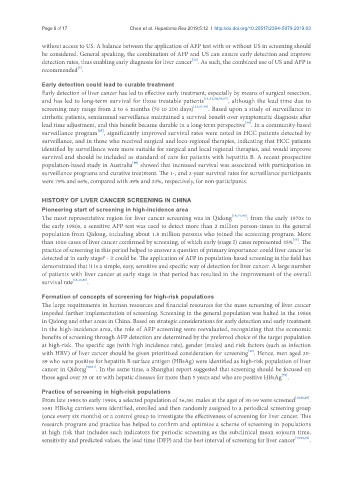Page 143 - Read Online
P. 143
Page 6 of 17 Chen et al. Hepatoma Res 2019;5:12 I http://dx.doi.org/10.20517/2394-5079.2019.03
without access to US. A balance between the application of AFP test with or without US in screening should
be considered. General speaking, the combination of AFP and US can ensure early detection and improve
[20]
detection rates, thus enabling early diagnosis for liver cancer . As such, the combined use of US and AFP is
[5]
recommended .
Early detection could lead to curable treatment
Early detection of liver cancer has led to effective early treatment, especially by means of surgical resection,
and has led to long-term survival for those treatable patients [11,21,30,76,87] , although the lead time due to
screening may range from 2 to 6 months (70 to 200 days) [23,37,39] . Based upon a study of surveillance in
cirrhotic patients, semiannual surveillance maintained a survival benefit over symptomatic diagnosis after
[39]
lead time adjustment, and this benefit became durable in a long-term perspective . In a community-based
[88]
surveillance program , significantly improved survival rates were noted in HCC patients detected by
surveillance, and in those who received surgical and loco-regional therapies, indicating that HCC patients
identified by surveillance were more suitable for surgical and local regional therapies, and would improve
survival and should be included as standard of care for patients with hepatitis B. A recent prospective
[89]
population-based study in Australia showed that increased survival was associated with participation in
surveillance programs and curative treatment. The 1-, and 2-year survival rates for surveillance participants
were 79% and 66%, compared with 49% and 33%, respectively, for non-participants.
HIsTORy Of lIveR CANCeR sCReeNINg IN CHINA
Pioneering start of screening in high-incidence area
The most representative region for liver cancer screening was in Qidong [16,19,90] : from the early 1970s to
the early 1980s, a sensitive AFP test was used to detect more than 2 million person-times in the general
population from Qidong, including about 1.8 million persons who joined the screening program. More
[15]
than 1000 cases of liver cancer confirmed by screening, of which early (stage I) cases represented 35% . The
practice of screening in this period helped to answer a question of primary importance: could liver cancer be
detected at in early stage? - it could be. The application of AFP in population-based screening in the field has
demonstrated that it is a simple, easy, sensitive and specific way of detection for liver cancer. A large number
of patients with liver cancer at early stage in that period has resulted in the improvement of the overall
survival rate [15,16,30] .
Formation of concepts of screening for high-risk populations
The large requirements in human resources and financial resources for the mass screening of liver cancer
impeded further implementation of screening. Screening in the general population was halted in the 1980s
in Qidong and other areas in China. Based on strategic considerations for early detection and early treatment
in the high-incidence area, the role of AFP screening were reevaluated, recognizing that the economic
benefits of screening through AFP detection are determined by the preferred choice of the target population
at high-risk. The specific age (with high incidence rate), gender (males) and risk factors (such as infection
[42]
with HBV) of liver cancer should be given prioritized consideration for screening . Hence, men aged 30-
59 who were positive for hepatitis B surface antigen (HBsAg) were identified as high-risk population of liver
cancer in Qidong [90,91] . In the same time, a Shanghai report suggested that screening should be focused on
[92]
those aged over 35 or 40 with hepatic diseases for more than 5 years and who are positive HBsAg .
Practice of screening in high-risk populations
From late 1980s to early 1990s, a selected population of 36,381 males at the ages of 30-59 were screened [19,90,93] .
5581 HBsAg carriers were identified, enrolled and then randomly assigned to a periodical screening group
(once every six months) or a control group to investigate the effectiveness of screening for liver cancer. This
research program and practice has helped to confirm and optimize a scheme of screening in populations
at high risk that includes such indicators for periodic screening as the subclinical mean sojourn time,
sensitivity and predicted values, the lead time (DPP) and the best interval of screening for liver cancer [19,93,94] .

